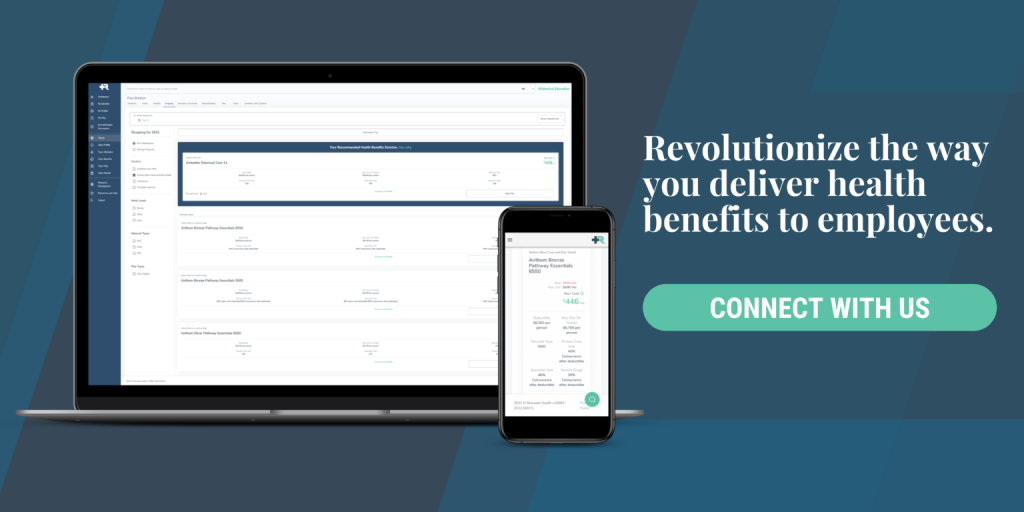
As a small business owner, juggling the rising costs of employee benefits can be overwhelming.
Business owners often face the continuous search for ways to keep their team happy and healthy without breaking the bank. The good news is that there’s a smarter solution to manage health benefits—one that lets you reimburse medical and dental expenses while maintaining flexibility and control.
Health Reimbursement Arrangements (HRAs) provide a unique way for employers to fund health expenses directly, giving employees more options to choose the best plans for themselves. In this blog, we’ll discuss the essentials of HRAs: how they work, their types, and the advantages they offer for employers and employees.
Understanding HRAs
Health Reimbursement Arrangements (HRAs) originated in 1974 with the Employee Retirement Income Security Act (ERISA) to help employers reimburse employees for medical expenses tax-free. Over the years, HRAs evolved with more flexibility and tax advantages. A significant milestone was in 2002 when the IRS formally recognized HRAs, further encouraging their use. The Affordable Care Act (ACA) in 2010 reshaped HRAs by introducing new rules and requirements, leading to the creation of specific types like the Qualified Small Employer HRA (QSEHRA) in 2016 and the Individual Coverage HRA (ICHRA) in 2020.
Types of HRAs
HRAs come in several forms, each tailored to different employer needs and health plan structures. Here’s a breakdown of the main types:
Integrated HRA
An Integrated HRA works alongside a group health insurance plan. Employers offer it to help cover out-of-pocket costs like deductibles, copayments, and medical expenses not fully paid by the group health plan. It’s ideal for businesses looking to enhance existing employee benefits.
Standalone HRA
A Standalone HRA is not tied to any health insurance plan. Employers can reimburse employees for a wide range of medical expenses. However, it doesn’t meet the requirements under the ACA for offering a qualified health plan. This limits its use mainly to retiree benefits or specific purposes.
Qualified Small Employer HRA (QSEHRA)
QSEHRAs are designed for small businesses with fewer than 50 employees. Employers use them to reimburse employees for health insurance premiums and medical expenses. Unlike traditional group health insurance, QSEHRA funds are tax-free, but they come with limits on maximum reimbursement amounts.
Individual Coverage HRA (ICHRA)
Introduced in 2020, ICHRAs allow employers of any size to reimburse employees for health insurance premiums and qualified medical expenses on a tax-free basis. Employees can choose their own health plans, providing flexibility and control.
How HRAs Work
HRAs are employer-funded accounts designed to reimburse employees for eligible healthcare expenses.Employers contribute a fixed amount to each employee’s HRA, which employees use for qualifying medical expenses, like doctor visits, prescriptions, and individual health insurance premiums. Unlike health savings accounts (HSAs), employees do not contribute to HRAs. Employers must determine the contribution amounts and eligible expenses to set up an HRA. They should also establish a clear plan document outlining rules and reimbursement procedures.
Compliance is critical. This involves adhering to federal regulations such as the IRS guidelines and the ACA requirements. Employers must maintain proper records, including receipts and proof of insurance, to validate reimbursements. Proper documentation must be maintained, like proof of expenses and employee communications. Employers should also periodically review their plans to stay updated with changes in healthcare laws and ensure that their HRA remains compliant with IRS and ACA regulations. Regular audits and clear communication with employees help maintain a successful HRA setup.
Learn more about how Remodel Health’s ICHRA+® product can benefit your organization
HRA vs. Other Health Benefits
When comparing HRAs to other health benefits, it’s important to understand the key differences. HRAs offer unique advantages but differ from HSAs, Flexible Spending Accounts (FSAs), and traditional health insurance.
HRA vs. Health Savings Accounts (HSA)
HSAs are employee-owned savings accounts for qualified health expenses, funded by both employers and employees. Unlike HRAs, HSAs require a high-deductible health plan. While HSAs provide long-term savings with tax benefits, HRAs offer more flexibility.
Pros of HSA
- Employee control over the account.
- Long-term savings for future medical expenses.
- Triple tax benefits: contributions, growth, and withdrawals are tax-free.
Cons of HSA
- Must be paired with a high-deductible health plan
- Contribution limits can restrict savings
HRA vs. Flexible Spending Accounts (FSA)
FSAs are employer-established accounts for employees to set aside pre-tax dollars for eligible medical expenses. However, unlike HRAs, FSAs typically have a “use-it-or-lose-it” rule each year.
Pros of FSA
- Tax advantages on employee contributions
- Allows pre-tax spending on eligible medical expenses
Cons of FSA
- Limited carryover; unused funds may be forfeited
- Not funded by employers; relies on employee contributions
HRA vs. Traditional Health Insurance
Traditional health insurance directly covers medical expenses but often comes with high premiums. HRAs provide an alternative by reimbursing employees for eligible expenses, offering more control over healthcare spending. HRAs can complement or replace traditional plans, especially for businesses wanting to manage costs effectively.
Pros of Traditional Health Insurance
- Direct coverage for a wide range of medical services
- Access to broad network options for care
Cons of Traditional Health Insurance
- Higher premiums and out-of-pocket costs
- Less flexibility and customization in benefits
Employer Perspectives
HRAs offer customization options that let employers design health plans tailored to different employee needs. Employers can choose which healthcare expenses are eligible, such as medical or dental costs, creating a personalized benefit package. Additionally, HRAs make budgeting and forecasting easier, as employers know the exact amount allocated for health expenses each year. This predictability supports better financial planning than a traditional health plan or health savings account.
Employee Perspectives
Managing ICHRAs offer financial advantages for employees through employer contributions, which are tax-free and can cover a range of healthcare costs. ICHRAs also provide flexibility, allowing employees to choose the best health insurance plan that suits their needs rather than being limited to a single group plan.
To maximize HRA benefits, employees should spend smartly, track eligible expenses, and manage reimbursements efficiently. Understanding what expenses are covered helps optimize usage. The expenses covered include:
- Medical expenses
- Dental and vision expenses
- Wellness programs and preventive care
Knowing these eligible expenses can help employees maximize this health benefit.
Future of HRAs
The future of HRAs is evolving with digital tools and platforms that make offering HRAs like ICHRAs easier for employers. Companies like Remodel Health provide technology to streamline plan management. This simplifies customizing benefits and enhances flexibility for different employee classes.
Impact of Policy Change
Potential policy changes could reshape the HRA landscape, impacting how these arrangements are managed and offered. For example, legislative updates may introduce new rules or incentives that affect employer contributions and the range of eligible expenses. Staying informed about policy shifts is important for employers and employees to make the most of their HRAs.
Why Health Reimbursement Arrangements are Essential for Modern Employers?
HRAs are transforming the landscape of employee benefits by offering flexible, tax-advantaged health reimbursement accounts. For employers, HRAs provide cost-effective and customizable solutions for managing health expenses. Employees can choose their preferred health insurance plans and receive reimbursements for eligible medical costs. As digital tools continue to evolve, managing HRAs becomes even more streamlined, enhancing both employer and employee experiences. If you want to enhance your employee benefits with a flexible and cost-effective solution, Remodel Health has the right solution for you!
At Remodel Health, we specialize in optimizing health benefits with innovative solutions. Our expert team provides the tools and support to tailor a health reimbursement account that aligns with your organization’s goals and employees’ needs. With our guidance, you can create a more personalized, compliant, and efficient health benefits strategy. Contact Remodel Health today to discover how we can help transform your employee health benefits experience.

